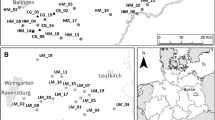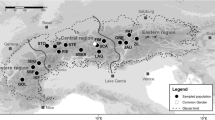Abstract
Climate change has the potential to alter the genetic diversity of plant populations with consequences for community dynamics and ecosystem processes. Recent research focused on changes in climatic means has found evidence of decreased precipitation amounts reducing genetic diversity. However, increased variability in climatic regimes is also predicted with climate change, but the effects of this aspect of climate change on genetic diversity have yet to be investigated. After 10 years of experimentally increased intra-annual variability in growing season precipitation regimes, we report that the number of genotypes of the dominant C4 grass, Andropogon gerardii Vitman, has been significantly reduced in native tallgrass prairie compared with unmanipulated prairie. However, individuals showed a different pattern of genomic similarity with increased precipitation variability resulting in greater genome dissimilarity among individuals when compared to unmanipulated prairie. Further, we found that genomic dissimilarity was positively correlated with aboveground productivity in this system. The increased genomic dissimilarity among individuals in the altered treatment alongside evidence for a positive correlation of genomic dissimilarity with phenotypic variation suggests ecological sorting of genotypes may be occurring via niche differentiation. Overall, we found effects of more variable precipitation regimes on population-level genetic diversity were complex, emphasizing the need to look beyond genotype numbers for understanding the impacts of climate change on genetic diversity. Recognition that future climate change may alter aspects of genetic diversity in different ways suggests possible mechanisms by which plant populations may be able to retain a diversity of traits in the face of declining biodiversity.




Similar content being viewed by others
References
Ackerly DD (2003) Community assembly, niche conservatism, and adaptive ecolution in changing environments. Int J Plant Sci 164:S165–S184
Arrigo N, Tuszynski JW, Ehrich D, Gerdes T, Alvarez N (2009) Evaluating the impact of scoring parameters on the structure of intra-specific genetic variation using RawGeno, an R package for automating AFLP scoring. BMC Bioinformatics 10:1–14
Avolio ML, Chang CC, Smith MD (2011) Assessing fine-scale genotypic structure of a dominant species in native grasslands. Am Midl Nat 165:211–224
Avolio ML, Beaulieu JM, Lo E, Smith MD (2012) Measuring genetic diversity in ecological studies. Plant Ecol 213:1105–1115
Bangert RK, Turek RJ, Rehill B, Wimp GM, Schweitzer JA, Allan GJ, Bailey JK, Martinsen GD, Keim P, Lindroth RL, Whitham TG (2006) A genetic similarity rule determines arthropod community structure. Mol Ecol 15:1379–1391
Benson EJ, Hartnett DC (2006) The role of seed and vegetative reproduction in plant recruitment and demography in tallgrass prairie. Plant Ecol 187:163–177
Beyene Y, Botha A, Myburg AA (2006) Genetic diversity in traditional Ethiopian highland maize accessions assessed by AFLP markers and morphological traits. Biodivers Conserv 15:2655–2671
Burdon JJ (1980) Intraspecific diversity in a natural-population of Trifolium-Repens. J Ecol 68:717–735
Clarke KR (1993) Nonparametric multivariate analyses of changes in community structure. Aust J Ecol 18:117–143
Clarke, KR, Gorley, RN (2006) PRIMER v6: user manual/tutorial. PRIMER-E, Plymouth
Crutsinger GM, Collins MD, Fordyce JA, Gompert Z, Nice CC, Sanders NJ (2006) Plant genotypic diversity predicts community structure and governs an ecosystem process. Science 313:966–968
Douhovnikoff V, Dodd RS (2003) Intra-clonal variation and a similarity threshold for identification of clones: application to Salix exigua using AFLP molecular markers. Theor Appl Genet 106:1307–1315
Etterson J (2008) Evolution in response to climate change. In: Carroll SP, Fox CW (eds) Conservation biology: evolution in action. Oxford University Press, Oxford, pp 145–163
Fay PA, Carlisle JD, Knapp AK, Blair JM, Collins SL (2000) Altering rainfall timing and quantity in a mesic grassland ecosystem: design and performance of rainfall manipulation shelters. Ecosystems 3:308–319
Fay PA, Blair JM, Smith MD, Nippert JB, Carlisle JD, Knapp AK (2011) Relative effects of precipitation variability and warming on tallgrass prairie ecosystem function. Biogeosciences 8:3053–3068
Felsenstein J (1985) Confidence-limits on phylogenies—an approach using the bootstrap. Evolution 39:783–791
Gienapp P, Teplitsky C, Alho JS, Mills JA, Merila J (2008) Climate change and evolution: disentangling environmental and genetic responses. Mol Ecol 17:167–178
Goslee SC, Urban DL (2007) The ecodist package for dissimilarity-based analysis of ecological data. J Stat Softw 22:1–19
Heisler JL, Weltzin JF (2006) Variability matters: towards a perspective on the influence of precipitation on terrestrial ecosystems. New Phytol 172:189–192
Helm A, Oja T, Saar L, Takkis K, Talve T, Pärtel M (2009) Human influence lowers plant genetic diversity in communities with extinction debt. J Ecol 97:1329–1336
Hewitt GM, Nichols RA (2005) Genetic and evolutionary impacts of climate change. In: Lovejoy TE, Hannah LJ (eds) Climate change and biodiversity. Yale University Press, New Haven, pp 176–192
Hoffmann AA, Willi Y (2008) Detecting genetic responses to environmental change. Nat Rev Genet 9:421–432
Holland BR, Clarke AC, Meudt HM (2008) Optimizing automated AFLP scoring parameters to improve phylogenetic resolution. Syst Biol 57:347–366
Hughes AR, Stachowicz JJ (2004) Genetic diversity enhances the resistance of a seagrass ecosystem to disturbance. Proc Natl Acad Sci USA 101:8998–9002
IPCC (2007) Climate Change 2007: The physical science basis. Contribution of Working Group I to the Fourth Assessment Report of the Intergovernmental Panel on Climate Change. Cambridge University Press, Cambridge
Jump AS, Penuelas J (2005) Running to stand still: adaptation and the response of plants to rapid climate change. Ecol Lett 8:1010–1020
Jump AS, Hunt JM, Martinez-Izquierdo JA, Penuelas J (2006) Natural selection and climate change: temperature-linked spatial and temporal trends in gene frequency in Fagus sylvatica. Mol Ecol 15:3469–3480
Jump AS, Penuelas J, Rico L, Ramallo E, Estiarte M, Martinez-Izquierdo JA, Lloret F (2008) Simulated climate change provokes rapid genetic change in the Mediterranean shrub Fumana thymifolia. Glob Change Biol 14:637–643
Jump AS, Marchant R, Penuelas J (2009) Environmental change and the option value of genetic diversity. Trends Plant Sci 14:51–58
Kembel S, Ackerly D, Blomberg S, Cowan P, Helmus M, Morlon H, Webb CO (2009) Picante: R tools for integrating phlogenies and ecology. R package version 05-3
Knapp AK, Fay PA, Blair JM, Collins SL, Smith MD, Carlisle JD, Harper CW, Danner BT, Lett MS, McCarron JK (2002) Rainfall variability, carbon cycling, and plant species diversity in a mesic grassland. Science 298:2202–2205
Knapp AK, Beier C, Briske DD, Classen AT, Luo Y, Reichstein M, Smith MD, Smith SD, Bell JE, Fay PA, Heisler JL, Leavitt SW, Sherry R, Smith B, Weng E (2008) Consequences of more extreme precipitation regimes for terrestrial ecosystems. Bioscience 58:811–821
Lasso E (2007) The importance of setting the right genetic distance threshold for identification of clones using amplified fragment length polymorphism: a case study with five speices in the tropic plant genus Piper. Mol Ecol Notes 8:74–82
Lovejoy TE, Hannah LJ (2005) Climate change and biodiversity. Yale University Press, New Haven
Meirmans PG, Van Tienderen PH (2004) GENOTYPE and GENODIVE: two programs for the analysis of genetic diversity of asexual organisms. Mol Ecol Notes 4:792–794
Mock KE, Rowe CA, Hooten MB, Dewoody J, Hipkins VD (2008) Clonal dynamics in western north American aspen (Populus tremuloides). Mol Ecol 17:4827–4844
Noli E, Teriaca MS, Sanguineti MC, Conti S (2008) Utilization of SSR and AFLP markers for the assessment of distinctness in durum wheat. Mol Breeding 22:301–313
Odat N, Jetschke G, Hellwig FH (2004) Genetic diversity of Ranunculus acris L. (Ranunculaceae) populations inferred in relation to species diversity and habitat type in grassland communities. Mol Ecol 13:1251–1257
Oksanen J, Kindt R, Legendre P, O’Hara B, Simpson GL, Stevens HH (2012) vegan: Community ecology package. R package version 111-4
Pan JJ, Price JS (2001) Fitness and evolution in clonal plants: the impact of clonal growth. Evol Ecol 15:583–600
Ramakrishnan AP, Meyer SE, Waters J, Stevens MR, Coleman CE, Fairbanks DJ (2004) Correlation between molecular markers and adaptively significant genetic variation in Bromus tectorum (Poaceae), an inbreeding annual grass. Am J Bot 91:797–803
Reusch TBH, Bostrom C (2011) Widespread genetic mosaicism in the marine angiosperm Zostera marina is correlated with clonal reproduction. Evol Ecol 25:899–913
Reusch TBH, Wood TE (2007) Molecular ecology of global change. Mol Ecol 16:3973–3992
Reusch TBH, Ehlers A, Hammerli A, Worm B (2005) Ecosystem recovery after climatic extremes enhanced by genotypic diversity. Proc Natl Acad Sci USA 102:2826–2831
Silvertown J, Biss PM, Freeland J (2009) Community genetics: resource addition has opposing effects on genetic and species diversity in a 150-year experiment. Ecol Lett 12:165–170
Smith MD (2011) The ecological role of climate extremes: current understanding and future prospects. J Ecol 99:651–655
Smith MD, Knapp A (2003) Dominant species maintain ecosystem function with non-random species loss. Ecol Lett 6:509–517
Smith MD, Knapp AK, Collins SL (2009) A framework for assessing ecosystem dynamics in response to chronic resource alterations induced by global change. Ecology 90:3279–3289
Stuefer JF, Anten NPR, de Kroon H, Peters JL, Smit-Tiekstra A, Vermeulen PJ, During HJ (2009) Genotypic selection shapes patterns of within-species diversity in experimental plant populations. J Ecol 97:1020–1027
Thomas C (2005) Recent evolutionary effects of climate change. In: Lovejoy TE, Hannah LJ (eds) Climate change and biodiversity. Yale University Press, New Haven, pp 75–88
Thompson JN (2009) Which ecologically important traits are most likely to evolve rapidly? Oikos 118:1281–1283
Vavrek MC, McGraw JB, Yang HS (1996) Within-population variation in demography of Taraxacum officinale: maintenance of genetic diversity. Ecology 77:2098–2107
Vellend M, Geber MA (2005) Connections between species diversity and genetic diversity. Ecol Lett 8:767–781
Vos P, Hogers R, Bleeker M, Reijans M, Vandelee T, Hornes M, Frijters A, Pot J, Peleman J, Kuiper M, Zabeau M (1995) Aflp—a new technique for DNA-fingerprinting. Nucleic Acids Res 23:4407–4414
Weaver JE (1954) North American prairie. Johnsen, Lincoln
Webb CO (2000) Exploring the phylogenetic structure of ecological communities: an example for rain forest trees. Am Nat 156:145–155
Webb CO, Ackerly DD, McPeek MA, Donoghue MJ (2002) Phylogenies and community ecology. Annu Rev Ecol Syst 33:475–505
Whitham TG, Bailey JK, Schweitzer JA, Shuster SM, Bangert RK, Leroy CJ, Lonsdorf EV, Allan GJ, DiFazio SP, Potts BM, Fischer DG, Gehring CA, Lindroth RL, Marks JC, Hart SC, Wimp GM, Wooley SC (2006) A framework for community and ecosystem genetics: from genes to ecosystems. Nat Rev Genet 7:510–523
Whitlock R, Hipperson H, Mannarelli M, Butlin RK, Burke T (2008) An objective, rapid and reproducible method for scoring AFLP peak-height data that minimizes genotyping error. Mol Ecol Resour 8:725–735
Wimp GM, Young WP, Woolbright SA, Martinsen GD, Keim P, Whitham TG (2004) Conserving plant genetic diversity for dependent animal communities. Ecol Lett 7:776–780
Acknowledgments
We thank A. Knapp, J. Blair, S. Collins and a number of research technicians, graduate students and undergraduates for their assistance with and maintenance of the RaMPs project, notably P. O’Neal. We also thank G. Caccone and the DNA analysis facility for support with the AFLP analysis. Thanks to C. Chang, T. Schreck, T. Nelson and S. Koerner for assistance in the field, and E. Lo for assisting with analysis of the genetic data. Lastly, we thank A. Knapp, S. Collins, G. Caccone, D. Post, C. Chang, and anonymous reviewers for comments on an earlier version of the manuscript. This research was supported by the US Department of Energy’s Program for Ecosystem Research (#DE-FG02-04ER63892), the USDA CSREES Ecosystem Studies Program, the NSF Ecosystems Program, and the NSF Long-Term Ecological Program at Konza Prairie. The experiment complies with the current laws of the United States of America where the experiment was performed.
Author information
Authors and Affiliations
Corresponding author
Additional information
Communicated by Bryan Foster.
Electronic supplementary material
Below is the link to the electronic supplementary material.
Rights and permissions
About this article
Cite this article
Avolio, M.L., Beaulieu, J.M. & Smith, M.D. Genetic diversity of a dominant C4 grass is altered with increased precipitation variability. Oecologia 171, 571–581 (2013). https://doi.org/10.1007/s00442-012-2427-4
Received:
Accepted:
Published:
Issue Date:
DOI: https://doi.org/10.1007/s00442-012-2427-4




